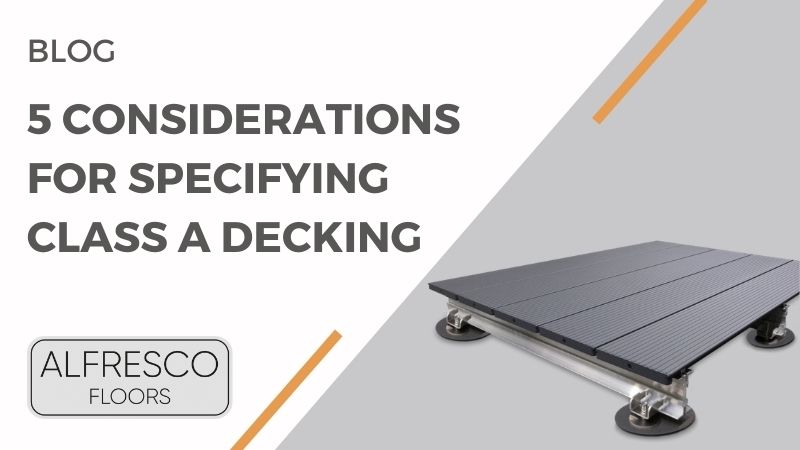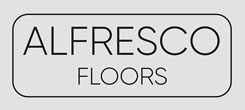
14 Jan 5 Considerations for Specifying Class A Decking

Due to current UK regulations, high rise residential buildings (over 18m) must specify non-combustible decking i.e. Class A decking on balconies. This means that all balconies and other external specified attachments must choose a safe and A-rated decking in order to be compliant.
In this article, we will discuss five key considerations for specifying Class A decking.
#1 Surface Material & Decking Aesthetic
An important part of specifying any decking is how it looks, and how it fits into the overall aesthetic of the building and environment.
Choosing a surface material for your Class A decking means you have a reduced number of options in comparison to other combustible surface options (such as timber or composite decking), however, there is still ample opportunity to get great aesthetic.
For a natural look, paving options such as porcelain or stone are versatile and durable. The texture can be adapted to give a variety of effects such as a wood-effect porcelain or a granite-look stone.
Concrete pavers are also a great solution, giving a cost-effective. practical and strong surface.
Finally, aluminium is a great class A decking option as it is modern, corrosion-resistant, and hard-wearing.
Depending on what your aims are and the purpose of application, these surface materials have their own unique characteristics, but all give you a safe fire-rated non-combustible deck.

#2 Class A Subframe & Joists
When specifying decking on a high-rise residential building, the whole system needs to be Class A-rated, not just the surface material. The decking sub-frame including joists, pedestals, and other components must also be non-combustible and compliant with regulations.
For example, if non-combustible porcelain tiles were laid on a combustible decking pedestal system, there is still at risk of contributing to the spread of fire.
For this example, Alfresco Floors offer the AR-Pave. It is a 100% aluminium Class A-rated paving support system comprising of adjustable pedestals, joists, spacer tabs, side stops, and end stops.
Alfresco Floors actually provide three Class A-rated sub-frame systems: A-PED, REIF DuraLink and AR-System, and they are the perfect solutions for your high rise specified attachment.
#3 Fire Rating vs Fire Resistance – Class A Compliance
Class A decking and subframes limit the spread of fire and smoke in the event of an emergency, keeping exit walkways safe for people, and allowing firefighters faster access.
The legislation in the UK requires all outer walls and specified attachments of residential buildings above 18m to have non-combustible materials. This means a fire-rating of A1 or A2.
It is important to consider that the materials you specify are fire-rated to the appropriate classification.
Fire-resistant materials have the potential to burn in the event of a fire. In addition, they may even combust and further spread the flames. While these materials should not greatly contribute to a fire, they are not permitted in high rise buildings.
You must specify Class A fire-rated materials in order to be safe, compliant, and avoid remedial action as a consequence of a fire inspection.

#4 Surface Slip Resistance
For external attachments, slip resistance is important due to the safety hazard that can be introduced in wet weather. When specifying Class A decking ensure your surface material either has a slip-resistant coating added or that a slip-resistant insert is added into the deckboard.
However, once again, make sure that any use of combustible material i.e. a rubber insert, isn’t specified, as this will not be permitted on Class A decking.
We recommend, therefore, opting for a slip-resistant coating, as it should mean that the product remains Class A rated whilst still being an effective anti-slip option.
#5 Sustainability
When considering your Class A decking, you should also consider the sustainability and the impact your product choice can have on the environment. Using natural, recycled, or recyclable material is the best option for a sustainably developed building.
Aluminium is also a sustainable option for Class A decking as it is made from recycled material, and also able to be recycled again. Additionally, recycling aluminium uses just 5% of the energy it takes to produce primary aluminium, making it a very valuable material that can be repeatedly recycled.
The light weight of aluminium also makes it easier to transport, reducing carbon emissions. It also is long-lasting and durable due to its corrosion resistance, extending the life-span of the decking.

Conclusion: Class A Decking for High Rise Buildings
Non-combustible decking for high rise balconies, roof gardens, and other external attachments is extremely important for the safety of residents and visitors in high rise buildings.
When specifying Class A decking, you must consider the surface material, subframe, slip-resistant, sustainability, and fire-rating compliance.
The team at Alfresco Floors focus our efforts exclusively on the products and solutions that we know offer the best combination of not only fire safety but price, prestige, and practicality.
We provide a complete and comprehensive service to the market and have three Class A-rated sub-frame systems: A-PED, REIF DuraLink and AR-System (AR-Deck and AR-Pave.)
To find out more about our products, call us on



Pingback:What Are the Regulations Around Class A Decking? - Alfresco Floors
Posted at 07:47h, 22 February[…] 5 Considerations for Specifying Class A Decking 3 Mistakes to Avoid with Class A Decking Why is Class A Decking Important? […]